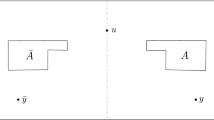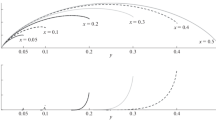Abstract
Consider the nearest-neighbor Ising model on \(\Lambda _n:=[-n,n]^d\cap {\mathbb {Z}}^d\) at inverse temperature \(\beta \ge 0\) with free boundary conditions, and let \(Y_n(\sigma ):=\sum _{u\in \Lambda _n}\sigma _u\) be its total magnetization. Let \(X_n\) be the total magnetization perturbed by a critical Curie–Weiss interaction, i.e.,
where \(F_{X_n}\) and \(F_{Y_n}\) are the distribution functions for \(X_n\) and \(Y_n\) respectively. We prove that for any \(d\ge 4\) and \(\beta \in [0,\beta _c(d)]\) where \(\beta _c(d)\) is the critical inverse temperature, any subsequential limit (in distribution) of \(\{X_n/\sqrt{{\mathbb {E}}\left( X_n^2\right) }:n\in {\mathbb {N}}\}\) has an analytic density (say, \(f_X\)) all of whose zeros are pure imaginary, and \(f_X\) has an explicit expression in terms of the asymptotic behavior of zeros for the moment generating function of \(Y_n\). We also prove that for any \(d\ge 1\) and then for \(\beta \) small,
where \(C=\sqrt{\Gamma (3/4)/\Gamma (1/4)}\) and \(K=\sqrt{\Gamma (3/4)}/(4\Gamma (5/4)^{3/2})\). Possible connections between \(f_X\) and the high-dimensional critical Ising model with periodic boundary conditions are discussed.
Similar content being viewed by others
Data Availibility
Data sharing is not applicable to this article as no datasets were generated or analysed during the current study.
References
Aizenman, M.: Geometric analysis of \(\varphi ^4\) fields and Ising models. parts I and II. Commun. Math. Phys. 86(1), 1–48 (1982)
Aizenman, M., Barsky, D.J., Fernández, R.: The phase transition in a general class of Ising-type models is sharp. J. Stat. Phys. 47(3), 343–374 (1987)
Aizenman, M., Duminil-Copin, H.: Marginal triviality of the scaling limits of critical 4D Ising and \(\phi ^4_4\) models. Ann. Math. 194(1), 163–235 (2021)
Camia, F., Garban, C., Newman, C.M.: Planar Ising magnetization field II. Properties of the critical and near-critical scaling limits. Ann. l’IHP Prob. Stat. 52(1), 146–161 (2016)
Camia, F., Jiang, J., Newman, C.M.: The effect of free boundary conditions on the Ising model in high dimensions. Probab. Theory Relat. Fields 181(1), 311–328 (2021)
Chio, I., He, C., Ji, A.L., Roeder, R.K.: Limiting measure of Lee-Yang zeros for the Cayley tree. Commun. Math. Phys. 370(3), 925–957 (2019)
Durrett, R.: Probability: Theory and Examples, vol. 49. Cambridge University Press, Cambridge (2019)
Ellis, R.S., Newman, C.M.: Limit theorems for sums of dependent random variables occurring in statistical mechanics. Zeitschrift für Wahrscheinlichkeitstheorie und verwandte Gebiete 44(2), 117–139 (1978)
Ellis, R.S., Newman, C.M., Rosen, J.S.: Limit theorems for sums of dependent random variables occurring in statistical mechanics. Zeitschrift für Wahrscheinlichkeitstheorie und verwandte Gebiete 51(2), 153–169 (1980)
Friedli, S., Velenik, Y.: Statistical Mechanics of Lattice Systems: A Concrete Mathematical Introduction. Cambridge University Press, Cambridge (2017)
Fröhlich, J.: On the triviality of \(\lambda \phi _d^4\) theories and the approach to the critical point in \(d\ge 4\) dimensions. Nucl. Phys. B 200(2), 281–296 (1982)
Greenstein, D.S.: On the analytic continuation of functions which map the upper half plane into itself. J. Math. Anal. Appl. 1, 355–362 (1960)
Griffiths, R.B., Hurst, C.A., Sherman, S.: Concavity of magnetization of an Ising ferromagnet in a positive external field. J. Math. Phys. 11(3), 790–795 (1970)
Grimm, J., Elçi, E.M., Zhou, Z., Garoni, T.M., Deng, Y.: Geometric explanation of anomalous finite-size scaling in high dimensions. Phys. Rev. Lett. 118(11), 115701 (2017)
Grimmett, G.R.: The Random-Cluster Model, vol. 333. Springer, New York (2006)
Hutchcroft, T., Michta, E., Slade, G.: High-dimensional near-critical percolation and the torus plateau. ar**v preprint ar**v:2107.12971 (2021)
Lee, T.-D., Yang, C.-N.: Statistical theory of equations of state and phase transitions. II. Lattice gas and Ising model. Phys. Rev. 87(3), 410 (1952)
Marden, M.: Geometry of Polynomials, vol. 3. American Mathematical Soc, Providence (1966)
Newman, C.M.: Inequalities for Ising models and field theories which obey the Lee-Yang theorem. Commun. Math. Phys. 41(1), 1–9 (1975)
Newman, C.M.: Fourier transforms with only real zeros. Proc. Am. Math. Soc. 61(2), 245–251 (1976)
Newman, C.M.: Normal fluctuations and the FKG inequalities. Commun. Math. Phys. 74(2), 119–128 (1980)
Newman, C.M., Wu, W.: Lee-Yang property and Gaussian multiplicative chaos. Commun. Math. Phys. 369(1), 153–170 (2019)
Ott, S.: Weak mixing and analyticity of the pressure in the Ising model. Commun. Math. Phys. 377(1), 675–696 (2020)
Papathanakos, V.: Finite-size effects in high-dimensional statistical mechanical systems: the Ising model with periodic boundary conditions. PhD Thesis Princeton University, Princeton, New Jersey (2006)
Peters, H., Regts, G.: Location of zeros for the partition function of the Ising model on bounded degree graphs. J. Lond. Math. Soc. 101(2), 765–785 (2020)
Rosenblum, M., Rovnyak, J.: Topics in Hardy Classes and Univalent Functions. Springer, New York (1994)
Ruelle, D.: Extension of the Lee-Yang circle theorem. Phys. Rev. Lett. 26(6), 303 (1971)
Simon, B., Griffiths, R.B.: The \((\phi ^4)_2\) field theory as a classical Ising model. Commun. Math. Phys. 33(2), 145–164 (1973)
Slade, G.: The near-critical two-point function and the torus plateau for weakly self-avoiding walk in high dimensions. ar**v preprint ar**v:2008.00080 (2020)
Wittmann, M., Young, A.: Finite-size scaling above the upper critical dimension. Phys. Rev. E 90(6), 062137 (2014)
Yang, C.-N., Lee, T.-D.: Statistical theory of equations of state and phase transitions. I. Theory of condensation. Phys. Rev. 87(3), 404 (1952)
Zhou, Z., Grimm, J., Deng, Y., Garoni, T.M.: Random-length random walks and finite-size scaling on high-dimensional hypercubic lattices I: Periodic boundary conditions. ar**v preprint ar**v:2008.00913 (2020)
Zhou, Z., Grimm, J., Fang, S., Deng, Y., Garoni, T.M.: Random-length random walks and finite-size scaling in high dimensions. Phys. Rev. Lett. 121(18), 185701 (2018)
Acknowledgements
The research of the second author was partially supported by NSFC grant 11901394 and that of the third author by US-NSF grant DMS-1507019. The authors thank two anonymous reviewers for useful comments and suggestions.
Author information
Authors and Affiliations
Corresponding author
Additional information
Communicated by Aernout van Enter.
Publisher's Note
Springer Nature remains neutral with regard to jurisdictional claims in published maps and institutional affiliations.
Appendix: Limit Distribution of Lee–Yang Zeros When \(\beta <\beta _c(d)\)
Appendix: Limit Distribution of Lee–Yang Zeros When \(\beta <\beta _c(d)\)
In this appendix, we prove that when \(\beta <\beta _c(d)\), the limiting distribution of Lee–Yang zeros has no mass in an arc containing \(\exp (i0)\) of the unit circle. This is stated as a conjecture in Sect. 1.3 of [6]. As can be seen from below, the proof follows essentially from Theorem 1.2 of [12] and Theorem 1.5 of [23]. We present a slightly different and relatively self-contained proof here which might be better suited to the context. We came up with this proof before we knew of the existence of [12].
Let \(\Lambda \subseteq {\mathbb {Z}}^d\) be finite. The Ising model on \(\Lambda \) at inverse temperature \(\beta \ge 0\) with free boundary conditions and external field \(h\in {{\mathbb {R}}}\) is defined by the probability measure \({\mathbb {P}}_{\Lambda ,\beta ,h}\) on \(\{-1,+1\}^{\Lambda }\) such that for each \(\sigma \in \{-1,+1\}^{\Lambda }\)
where the first sum is over all nearest-neighbor edges in \(\Lambda \), and \(Z_{\Lambda ,\beta ,h}\) is the partition function that makes (127) a probability measure. In this appendix, we will consider complex \(h\in {\mathbb {C}}\). A famous result due to Lee and Yang [17] is that \(Z_{\Lambda ,\beta ,h}\ne 0\) if \(h\notin i{\mathbb {R}}\) where \(i{\mathbb {R}}\) denotes the pure imaginary axis. So the fraction in (127) is well-defined if \(h\notin i{\mathbb {R}}\) but it could take a complex value, and thus \({\mathbb {P}}_{\Lambda ,\beta ,h}\) is a complex measure. Let \(\langle \cdot \rangle _{\Lambda ,\beta ,h}\) denote the expectation with respect to \({\mathbb {P}}_{\Lambda ,\beta ,h}\). For example, the magnetization at \(u\in \Lambda \) is defined by
Let \(\Lambda _n:=[-n,n]^d\cap {\mathbb {Z}}^d\) and \(E_n\) be the set of all nearest-neighbor edges \(\{u,v\}\) with \(u,v\in \Lambda _n\). Note that
Let \(z=e^{-2h}\) throughout the appendix and write \(Z_{\Lambda _n,\beta }(z):=Z_{\Lambda _n,\beta ,h}\). Then the outmost sum in (130) is a polynomial of z with degree \(|\Lambda _n|\). So by the fundamental theorem of algebra, \(Z_{\Lambda _n,\beta }(z)\) has exactly \(|\Lambda _n|\) complex roots. The Lee–Yang circle theorem [17] says that these \(|\Lambda _n|\) roots are on the unit circle \(\partial {\mathbb {D}}\) where \({\mathbb {D}}:=\{z\in {\mathbb {C}}:|z|<1\}\) is the unit disk. So we may assume that these roots are
Note that we have used the fact that \(Z_{\Lambda _n,\beta }(1)>0\). By the spin-flip symmetry, \(Z_{\Lambda _n,\beta ,-h}=Z_{\Lambda _n,\beta ,h}\) for any \(h\in {\mathbb {C}}\). As a result, those \(|\Lambda _n|\) roots in (131) are symmetric with respect to the real-axis. Combining (130) and (131), we have
Here we take out \((-\infty ,0]\) from \({\mathbb {C}}\) so that \(h=-(\ln z)/2\) is analytic in this slit domain. Therefore,
It is easy to see that
We define the average magnetization density in \(\Lambda _n\) by
where we have dropped the \(\beta \) dependence in \(m_{\Lambda _n}(z)\). By (133) and (134), we have
By using the definition of \(\langle \cdot \rangle _{\Lambda ,\beta ,h}\) (see (128)), we know that \(m_{\Lambda _n}(z)\) is a rational function of z with poles on \(\partial {\mathbb {D}}\), and thus (136) holds for each \(z\in {\mathbb {D}}\). We define the empirical distribution
where \(\delta _{\exp (i\theta _{j,n})}\) is the unit Dirac point measure at \(\exp (i\theta _{j,n})\). Then
Since \(\mu _n\)’s live on the unit circle, \(\{\mu _n:n\in {\mathbb {N}}\}\) is tight. So there is a subsequence of \({\mathbb {N}}\), \(\{n_k:k\in {\mathbb {N}}\}\), such that \(\mu _{n_k}\Longrightarrow \mu \) as \(k\rightarrow \infty \) where \(\mu \) is some probability measure on \(\partial {\mathbb {D}}\). We will see later that \(\mu \) is actually unique. Therefore,
Note that
and \(m_{\Lambda _n}(0)=1\). So \(m_{\Lambda _n}\) is a Herglotz function. See Sect. 8.4 of [26] for more details. From (138), we know
So \(\{m_{\Lambda _n}:n\in {\mathbb {N}}\}\) is locally uniformly bounded. It is well-known that
where \(\langle \cdot \rangle _{{\mathbb {Z}}^d,\beta ,h}\) is the expectation with respect to the unique infinite volume measure when \(\beta \ge 0\) and \(h>0\) (see, e.g., Proposition 3.29 and Theorem 3.46 of [10]). So by Vitali’s theorem (see, e.g., Theorem B.25 of [10]),
exists locally uniformly on \({\mathbb {D}}\) and m is a Herglotz function. Comparing (139) and (143), we obtain
We define
Since \(\langle \sigma _x\rangle _{\Lambda _n,\beta ,h}=-\langle \sigma _x\rangle _{\Lambda _n,\beta ,-h}\) for any \(x\in \Lambda _n\) and \(h\in {\mathbb {C}}\setminus i{\mathbb {R}}\), we get
The following Stieltjes inversion formula on page 12 of [26] will be very import to our analysis of \(\mu \).
Theorem A
(Stieltjes Inversion Formula) Let \(\gamma :=\{e^{it}: a<t<b\}\) be an open arc on \(\partial {\mathbb {D}}\) with endpoints \(e^{ia}\) and \(e^{ib}\), \(0<b-a<2\pi \). Then
In particular, Theorem A implies the \(\mu \) that we obtained from the subsequential limit is unique, that is, we have \(\mu _n\Longrightarrow \mu \) as \(n\rightarrow \infty \). We call \(\mu \) the limiting distribution of Lee–Yang zeros. Note that \(\mu \) is actually a function of \(\beta \). Let \(\beta _c(d)\) be the critical inverse temperature of the Ising model on \({\mathbb {Z}}^d\). We are ready to prove the main result about \(\mu \).
Theorem B
For any \(d\ge 1\) and any \(\beta \in [0,\beta _c(d))\), there is \(\epsilon >0\) (which only depends on \(\beta \) and d) such that
Proof
By Theorem A,
By Theorem 1.5 of [23], we have that m(z) is complex analytic in a neighborhood of \(z=1\). So we may pick \(\epsilon \) small such that m is analytic in \(D(1,2\epsilon ):=\{z\in {\mathbb {C}}:|z-1|<2\epsilon \}\). Then both \(\Re m(re^{-i\theta }) \) and \(\Re m(re^{i\theta }) \) are bounded if \(re^{-i\theta }\) and \(re^{i\theta }\) are in \(D(1,\epsilon )\). The dominated converge theorem implies that
By (145) and (146), and continuity of m in \(D(1,2\epsilon )\), we have
Plugging this into (153), we get
which concludes the proof of the theorem. \(\square \)
Rights and permissions
About this article
Cite this article
Camia, F., Jiang, J. & Newman, C.M. Ising Model with Curie–Weiss Perturbation. J Stat Phys 188, 5 (2022). https://doi.org/10.1007/s10955-022-02935-1
Received:
Accepted:
Published:
DOI: https://doi.org/10.1007/s10955-022-02935-1




